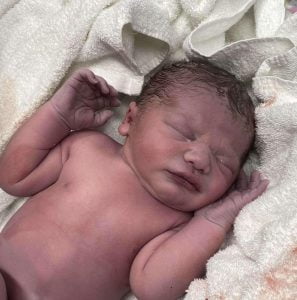
The miraculous transition from womb to world marks the beginning of a newborn’s journey into life. One of the most remarkable transformations during this process is the change in the baby’s skin tone, shifting from a shade of blue to a healthy pink complexion. This transition only happens due to a profound shift in the newborn’s circulatory blood system. In honour of this year’s Sweetheart Day on 14th Feb we are going explore the key factors contributing to this miraculous transformation.
The Transition from Blue to Pink;

1. Establishment of blood flow:
While in the womb, the baby’s circulatory system relies on the placenta for oxygen exchange. Upon birth, a series of physiological changes occur rapidly to facilitate the newborns transition to breathing air. As the baby takes their first breath, the lungs expand, initiating the flow of oxygen-rich air into the tiny air sacs or “alveoli”. This triggers a decrease in resistance or ‘pressure’ in the lungs and an increase in blood flow, allowing for efficient oxygenation of the blood in the lungs.
2. Closure of Newborn Shunts:
During normal development of your baby, two holes known as a shunt, develop in the heart that allows blood to move between the pulmonary (un-oxygenated blood) and systemic (oxygenated) circulatory system. They are known called the ductus arteriosus and… foramen ovale (see pic below)
These shunts allow essential functions in bypassing non-functioning baby’s lungs. However, after birth, these shunts must close to redirect blood flow appropriately. The ductus arteriosus constricts in response to increased oxygen levels, pushing blood back towards the lungs. Simultaneously, the foramen ovale closes as pressure in the left side of the heart exceeds that in the right, preventing any backflow of unoxygenated blood from the pulmonary system. There are now 2 separate systems pumping blood from the heart to the body and from the lungs to the heart.
 3.Increase in systemic circulation:
3.Increase in systemic circulation:
As pulmonary circulation improves and the baby’s shunts close, oxygen-rich blood from the lungs is pumped into the left side of the heart and then distributed to the body via the systemic circulation. This oxygenated blood replaces the deoxygenated blood that previously circulated through your baby’s body, leading to an overall increase in oxygen levels which causes the skin to become pinker in tone.
4. Peripheral Vasodilation:
With the establishment of efficient pulmonary and systemic circulation, the body’s oxygen supply increases, triggering changes in the outer limbs and skin’s blood supply to dilate. This dilation of blood vessels in the skin and extremities allows for enhanced blood flow to these areas, resulting in the characteristic pink complexion seen in healthy newborns.
When to be concerned?
While seeing your baby blue-toned can be alarming, it’s often a temporary and benign occurrence as the newborn’s blood system adjusts to life outside the womb over the course of the first day or two. However, if it persists for longer or your baby has severe blue limbs and body known as ‘cyanosis’, prompt immediate action is required to ensure the baby receives proper evaluation and care by medical professionals.
Symptoms of concern to look for include;
- persistent blue toned hands, feet and lips. (insert pic)
- fast, strenuous breathing (including noisy breathing).
- exhaustion upon feeding, including blue lips.
- floppy episodes accompanied by blue lips and face.
What to do?
Seek medical attention immediately;
– call 000
– Attend your nearest emergency department safely- ideally have a responsible adult watching your child in the car seat whilst driving.
** Know how to confidently perform baby and child first aid .You can learn with us HERE
Conclusion:
The journey from blue to pink symbolizes more than just a change in skin tone—it represents the successful adaptation of your baby’s blood system to life outside the womb. As a parent it is important to understand the intricate mechanisms underlying this transition can provide insight into the remarkable capability of the human body. Furthermore, it is important to know when to seek immediate help if symptoms persistent or symptoms of concern appear to ensure your baby receives proper evaluation and care. Equipping yourself and your family with the skills and knowledge to perform essential baby and child first aid is an amazing way to empower yourself as a parent. So hopefully now you can enjoy those warm newborn snuggles knowing exactly what is happening to your newborn!

